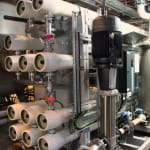 For the first time in Europe, Lanxess' fouling-resistant membrane technology is being used on a large scale at the Dammweg thermal power station in Chemnitz, Germany. A set of 60 Lewabrane RO B400 FR filter elements apply a reverse osmosis process to cleanse 50 to 60 cubic meters of pre-treated river water per hour for steam generation purposes. Dr. Jens Lipnizki, head of Technical Marketing Membranes in the Liquid Purification Technologies business unit at Lanxess, explains that "the 90 percent reduction in the organic contamination of river water demanded by the operator of the power plant can be easily achieved using our membrane technology."
For the first time in Europe, Lanxess' fouling-resistant membrane technology is being used on a large scale at the Dammweg thermal power station in Chemnitz, Germany. A set of 60 Lewabrane RO B400 FR filter elements apply a reverse osmosis process to cleanse 50 to 60 cubic meters of pre-treated river water per hour for steam generation purposes. Dr. Jens Lipnizki, head of Technical Marketing Membranes in the Liquid Purification Technologies business unit at Lanxess, explains that "the 90 percent reduction in the organic contamination of river water demanded by the operator of the power plant can be easily achieved using our membrane technology."The reverse osmosis facility in the Chemnitz power plant was developed and designed by the Celle-based water technology company Berkefeld, a subsidiary of the global group Veolia Water Solutions & Technologies. Veolia's water technology division is one of the world's leading providers of water treatment solutions. Its core competencies lie in the planning and realization of facilities for drinking and process water treatment and the purification and recycling of wastewater.
Chemnitz powerhouse
The "powerhouse" operator is eins energie in sachsen GmbH & Co. KG. Southern Saxony’s leading municipal energy service provider has around 400,000 private and business customers, including more than 1,000 industrial clients.The Chemnitz thermal power plant, Saxony's highest structure with its 302-meter-high chimney, uses cogeneration to generate power and district heating. Two of the three blocks at the power plant are powered by native raw lignite using a low-emission incineration process with state-of-the-art dust removal and desulfurizing of the flue gas. The other is powered with natural gas or, alternatively, heating oil. Cogeneration technology is an optimized solution for utilizing fuels by simultaneously generating heat and electricity.
The power plant draws water for the cooling processes and steam production from the rivers Chemnitz and Zschopau. The water's intended use - as cooling water, process water or almost pure, completely desalinated water (demineralized water) for steam generation - determines the need for any complex mechanical and chemical treatment procedures. Even after it has been softened and desalinated using ion exchange resins, the water still contains a considerable amount of organic substances that cause excessive conductivity in the water-steam cycle that is harmful to the turbine and other components. The membrane filter elements from Lanxess lower the degree of fluctuation in water quality and in particular filter out organic substances. Some 90 percent of the feed water, the permeate, is used for the ensuing processes. The remaining approx. 10 percent, the concentrate, is also put to further use by adding it to the process water.



